Venous filling time - Study guides, Class notes & Summaries
Looking for the best study guides, study notes and summaries about Venous filling time? On this page you'll find 1619 study documents about Venous filling time.
Page 4 out of 1.619 results
Sort by
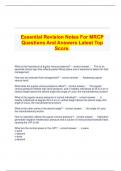
-
Essential Revision Notes For MRCP Questions And Answers Latest Top Score.
- Exam (elaborations) • 16 pages • 2024
-
- $10.99
- + learn more
Essential Revision Notes For MRCP Questions And Answers Latest Top Score. What is the importance of jugular venous pressure? - correct answer. This is an essential clinical sign that reflects patient filling status and is essential to detect for fluid management. How can we evaluate fluid management? - correct answer. Assessing jugular venous level. What does the jugular venous pressure reflect? - correct answer. The jugular venous pressure reflects high atrial...
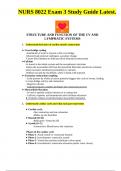
-
NURS 8022 Exam 3 Study Guide Latest.
- Exam (elaborations) • 48 pages • 2023
-
- $12.99
- + learn more
NURS 8022 Exam 3 Study Guide Latest. STRUCTURE AND FUNCTION OF THE CV AND LYMPHATIC SYSTEMS 1. Understand the basics of cardiac muscle contraction Cross-bridge cycling -Attachment of actin to myosin at the cross bridge -Myosin head molecule undergoes a position change -Causes thin filaments to slide past thick filaments (contraction) Calcium -Is stored in the tubule system and the sarcoplasmic reticulum -Enters the myocardial cell from the interstitial fluid after electrical excitatio...
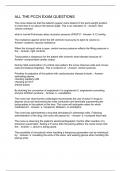
-
all the PCCN Exam Q&A
- Exam (elaborations) • 44 pages • 2023
-
- $13.65
- + learn more
The nurse observes that the patient's jugular veins distend in the semi-upright position to more than 5 cm above the sternal angle. This is an indication of: - Answer- fluid volume overload. what is normal Pulmonary artery occlusion pressure (PAOP)? - Answer- 5-12 mmHg The resistance against which the left ventricle must pump to eject its volume is: - Answer- systemic vascular resistance. When the tricuspid valve is open, central venous pressure reflects the filling pressure in the: - ...
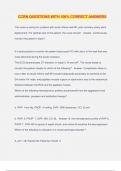
-
CCRN QUESTIONS WITH 100% CORRECT ANSWERS
- Exam (elaborations) • 35 pages • 2024
- Available in package deal
-
- $12.49
- + learn more
CCRN QUESTIONS WITH 100% CORRECT ANSWERS The nurse is caring for a patient with acute inferior wall MI, post-coronary artery stent deployment, For optimal care of the patient, the nurse should: - Answer- Continuously monitor the patient in lead II It is best practice to monitor the patient status post PCI with stent, in the lead that was most abnormal during the acute occlusion. The ECG demonstrates ST elevation in leads II, III and aVF. The nurse needs to monitor the patient closely for ...

-
All the PCCN Exam questions with all the correct answers 2024 Latest updated, Complete Verified Solution.
- Exam (elaborations) • 42 pages • 2024
-
- $10.49
- + learn more
All the PCCN Exam questions with all the correct answers 2024 Latest updated, Complete Verified Solution. The nurse observes that the patient's jugular veins distend in the semi-upright position to more than 5 cm above the sternal angle. This is an indication of: fluid volume overload. what is normal Pulmonary artery occlusion pressure (PAOP)? 5-12 mmHg The resistance against which the left ventricle must pump to eject its volume is: systemic vascular resistance. When the tricuspid va...
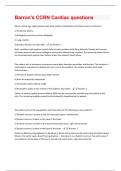
-
Barron's CCRN Cardiac Questions and Answers well Explained Latest 2024/2025 Update 100% Correct.
- Exam (elaborations) • 20 pages • 2024
- Available in package deal
-
- $7.99
- + learn more
Which clinical sign might patients with both systolic and diastolic heart failure have in common? a) Peripheral edema b) Enlarged heart size on chest radiograph c) Lung crackles d) Ejection fraction less than 40% - Answer: C Both a problem with ejection (systolic failure) and a problem with filling (diastolic failure) will increase left heart pressure and cause cardiogenic pulmonary edema (lung crackles). The remaining three choices are associated with systolic heart failure rather than d...
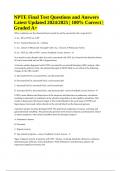
-
NPTE Final Test Questions and Answers Latest Updated 2024/2025 (100% Correct | Graded A+)
- Exam (elaborations) • 112 pages • 2024
-
- $17.99
- + learn more
NPTE Final Test Questions and Answers Latest Updated 2024/2025 (100% Correct | Graded A+) What conditions are the abnormal heart sounds S3 and S4 associated with, respectively? A. S3 = MI or HTN; S4 =CHF B. S3 = Tracheal Stenosis; S4 = Asthma C. S3 = closure of Mitral and Tricuspid Valves; S4 = Closure of Pulmonary Valves D. S3 = CHF; S4 =MI or HTN - answer Feedback Correct Answer - D S3 is heard in early diastole (after S2) and is associated with CHF. S4 is heard in late diastole (before ...
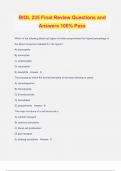
-
BIOL 235 Final Review Questions and Answers 100% Pass
- Exam (elaborations) • 31 pages • 2024
- Available in package deal
-
- $13.49
- + learn more
BIOL 235 Final Review Questions and Answers 100% Pass Which of the following blood cell types normally compromises the highest percentage of the blood component labeled 2 in the figure? A) eosinophils B) monocytes C) lymphocytes D) neutrophils E) basophils - Answer- D The process by which the formed elements of the blood develop is called A) hematospermia B) hemopoiesis C) thrombocytosis D) hemostasis E) polycythemia - Answer- B The major functions of a red blood cell is A) nutri...
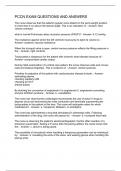
-
PCCN EXAM QUESTIONS AND ANSWERS
- Exam (elaborations) • 44 pages • 2023
-
- $13.49
- + learn more
The nurse observes that the patient's jugular veins distend in the semi-upright position to more than 5 cm above the sternal angle. This is an indication of: - Answer- fluid volume overload. what is normal Pulmonary artery occlusion pressure (PAOP)? - Answer- 5-12 mmHg The resistance against which the left ventricle must pump to eject its volume is: - Answer- systemic vascular resistance. When the tricuspid valve is open, central venous pressure reflects the filling pressure in the: - ...
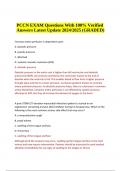
-
PCCN EXAM Questions With 100% Verified Answers Latest Update 2024/2025 (GRADED)
- Exam (elaborations) • 50 pages • 2024
-
- $17.49
- + learn more
PCCN EXAM Questions With 100% Verified Answers Latest Update 2024/2025 (GRADED) Coronary artery perfusion is dependent upon: A. diastolic pressure B. systolic pressure C. afterload D. systemic vascular resistance (SVR) A. diastolic pressure Diastolic pressure in the aortic root is higher than left ventricular end-diastolic pressure (LVEDP), the pressure exerted on the ventricular muscle at the end of diastole when the ventricle is full. This enables blood to flow from a higher pressure ...

How did he do that? By selling his study resources on Stuvia. Try it yourself! Discover all about earning on Stuvia


